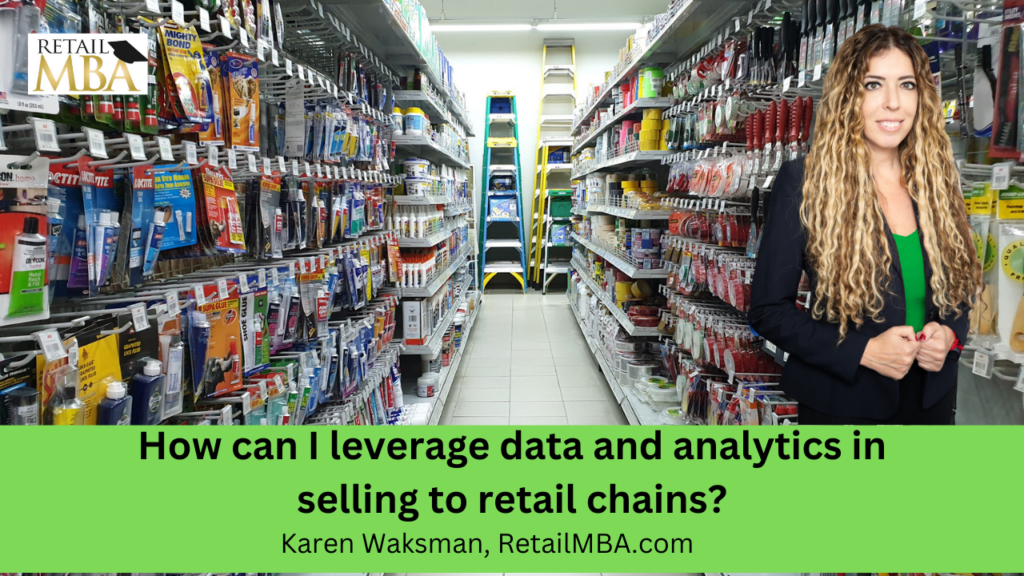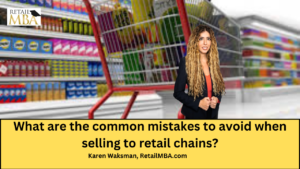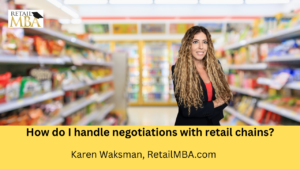How can I leverage data and analytics in selling to retail chains?
In this short video training, we will discuss the ways in which data and analytics can be utilized to enhance sales, in chains. Many individuals often wonder how they can adopt an approach when it comes to selling in a retail chain. Whether you are a buyer interested in data and analytics or simply curious about the process of receiving an order from a chain store this video offers insights.
The Role of Data and Analytics in Retail Chains
When collaborating with a chain like Walmart setting up software systems becomes essential. One such system is known as Electronic Data Interchange (EDI). EDI allows communication between your software system and the chains system enabling you to track deliveries and shipments efficiently. For instance Walmart has its EDI system that provides vendors with real time information on their relationship with the retail giant, including details on units sold.
Leveraging Data and Analytics with Retail Chains
Analyzing the information provided through the EDI system is one way to leverage data and analytics within chains. By examining this data you can pinpoint regions that are performing well compared to others and gain insights, into why certain stores may be experiencing sales.
For instance one reason, for this could be if your product is not positioned correctly in the store. By keeping track of data analytics you can promptly. Resolve any issues to ensure that your products are placed in the location at the right time.
Another situation to consider is when your product is displayed on a strip with clips. These strips consist of plastic strips with products hanging down between store shelves. However sometimes these clip strips are mistakenly placed in the section of the store resulting in sales. By analyzing data and pinpointing areas where your product isn’t selling well you can determine whether it’s due to an error by the retailer and take action.
Having an understanding of the analytics provided by chains is crucial for your businesss success. Neglecting to monitor this data could have an impact on your relationship with the chain. Potentially lead to lost sales. By leveraging data and analytics you can proactively address any issues that arise and ensure that your products are selling successfully.
Utilizing Data and Analytics to Persuade Retail Chains
In addition, to monitoring data and analytics within the chains system you can also utilize data as evidence when persuading chains to increase their purchases of your product.
If you have evidence of sales or data that demonstrates the performance of your product on platforms, like Amazon or your own website you can share this information with the buyer. By showcasing the success and conversion rates of your product you can establish trust. Encourage the chain to increase their order quantity.
In conclusion data and analytics play a role in selling to chains. By utilizing information provided through systems like EDI you can gain insights into your relationship with the chain. Identify areas for improvement. Monitoring data analytics allows you to promptly address any issues and ensure that your products are selling well. Moreover presenting data and analytics to chains can help persuade them to purchase units of your product. It is essential to be proactive and make use of data to strengthen your relationship with chains and drive sales.
If you’re interested in learning more about approaching, pitching and selling to chain stores well as understanding what happens once you receive a chain store order we recommend exploring our coaching and training programs while also considering attending our live events. We are committed to supporting your success, in the industry.video

Today, we’re diving deep into the crucial topic of creating effective sales forecasts for retail chains. As Karen wisely points out, retail chains are driven by one overarching goal—making money. Understanding how to navigate the intricacies of sales forecasts is paramount when dealing with these corporate giants. Let’s unravel the mystery and explore strategies to craft compelling sales forecasts that resonate with retail buyers.
The Essence of Sales Forecasts in the Retail Landscape
Retail chains, with their vast networks of stores and online platforms, invest substantially in curating a selection of products that cater to their target audience. To ensure a seamless partnership, buyers often seek insights into what sellers anticipate in terms of sales. While predicting sales can be a nuanced and somewhat speculative endeavor, Karen offers practical insights to demystify the process.
Strategies for Crafting Effective Sales Forecasts
1. Leverage Your Online Sales Data:
If you’re already selling your product online, leverage your existing sales data as a foundation for your sales forecast. By showcasing your current sales performance, you provide buyers with tangible evidence of your product’s market appeal. Karen suggests emphasizing the number of units sold per month on your website as a key metric to underscore your product’s demand.
2. Analyze Similar Products:
For those who might not have an extensive sales history, Karen proposes a clever strategy—analyze similar products in the market. Investigate how many units comparable products are selling by visiting stores or researching online. This “market reconnaissance” allows you to make informed estimates about your potential sales based on the performance of analogous products.
3. Engage in Competitive Intelligence:
Delve into the competitive landscape to glean valuable insights. Karen recommends studying the sales figures of products similar to yours, either by physically visiting stores or scrutinizing online platforms. By assessing the number of units these products are moving, you can refine your sales forecast and align it with the market’s current dynamics.
4. Tap into Online Sales Rankings:
For products sold online, such as through e-commerce platforms, Karen suggests tapping into online sales rankings. Identify who the best sellers are in your category and attempt to obtain data on the number of units they are selling. This information serves as a benchmark for establishing realistic sales expectations for your own product.
5. Seek Insights from Store Managers:
An often-overlooked strategy involves engaging with store managers directly. These frontline personnel possess invaluable insights into product performance. By approaching store managers and discreetly inquiring about sales figures, you may gain candid and useful information that transcends the formality of corporate channels.
6. Inquire About Industry Averages:
During your interactions with buyers or assistant buyers, subtly inquire about industry averages. Politely ask for a range of sales volumes within your category. This approach, as Karen points out, is a clever way to extract valuable information without appearing intrusive. Industry averages provide a broader context for framing your sales forecast.
7. Consult Trade Associations:
For a more comprehensive understanding of industry trends, Karen recommends consulting trade associations. These organizations often provide valuable data and insights into sales forecasts for specific categories. By leveraging the resources of trade associations, you gain access to a wealth of information that can inform your sales projections.
The Role of Education in Crafting Informed Forecasts
Karen underscores the significance of education in this process. Entrepreneurs need to be proactive in seeking knowledge about their industry, market trends, and sales dynamics. The more informed you are, the better equipped you’ll be to navigate discussions with retail buyers and present compelling sales forecasts.
Retail MBA’s Advanced Coaching and Training System
For those eager to delve deeper into the art of approaching, pitching, and selling to retail chains, Karen introduces the Retail MBA Advanced Coaching and Training System. This comprehensive program not only guides you through the intricacies of sales forecasting but also offers personalized coaching. Entrepreneurs can leverage this system to gain insights tailored to their specific product category, ensuring a strategic and informed approach to retail success.
Approach with Confidence
In conclusion, Karen Waksman’s guidance unveils a pragmatic approach to creating effective sales forecasts for retail chains. As an entrepreneur, navigating the world of retail may seem daunting, but armed with insights into sales forecasting, you can approach buyers with confidence.
Whether you’re leveraging online sales data, analyzing similar products, or seeking insights from industry insiders, the key lies in being proactive and informed. The journey to retail success is a dynamic one, and your ability to craft compelling sales forecasts is a crucial step toward building lasting partnerships with retail chains.
Embrace the strategies shared by Karen, explore the nuances of your market, and remember that education is your ally. By mastering the art of sales forecasting, you position yourself as a savvy entrepreneur ready to conquer the competitive landscape of retail chains. The future of your product’s success in retail awaits—approach it with confidence, armed with knowledge and strategic foresight. Thank you for joining us in this insightful session with Karen Waksman, the guiding force behind Retail MBA.
Here are a few other blog posts you might be interested in:

Step-by-step training on how to sell to retail chains!
We explain exactly how to do that and how to get started today. I’ve taught over 100,000 of companies over the years across the globe on how to get your products to the stores. And so we’re here to support you. Or please subscribe to our Youtube channel and or be on the lookout for additional training that we create.
We are here to expedite the process of generating revenue with your physical products and that’s what we’re all about. Take a look at our advanced training, live events, certification programs and so much more.
In this training, I will discuss some of the things to think about when approaching a retailer to sell your products and become a vendor. Hope it helps! 🙂
Karen Waksman,
Retail MBA
Questions? Contact Us!
1-855-Retail-2 (Call or Text)
Email: info@retailmba.com
Retail MBA provides a step-by-step formula on How to Sell to Major Retailers, Online Retailers, Smaller Retailers, Catalogs and More. No Experience Required! These solutions continue to convert for clients year-over-year! These are Time-Tested and Proven Strategies that we utilize ourselves when going after stores! Everything we teach, we test. Want access to these formulas? ANY one of our programs and coaching systems gives you access to them now. With that said…
Here are 5 Easy Ways to Work with Us:
1) Free Training – If You Would Like to Join Our Next FREE Webinar Training Called “Retail Chain Store Secrets – How to Sell to Major Retail Chains. No Experience Required” Then Sign Up NOW To Learn All About Selling into Retail Chains By Clicking Here!
2) Retail MBA Year Long Coaching and Training System – Our Year Long Coaching and Training System with Karen Waksman is POWERFUL! This is our most popular training and coaching system! We walk you through how to approach, pitch and sell to retail chains and we coach you along the way! Join us by Clicking Here!
3) Masterclass Intensives – Want to Join our Next 4 Week Elite Retail MBA Masterclass Intensive? These Intensives Are EPIC for people who Love Fast Paced Learning – Homework, Retail Coaching, Developing Your Strategy, Buyers Contacts and More! These Events Are Held Every Quarter. Join us by Clicking Here!
4) Done-for-You Program – If You Want Karen Waksman and Her Team to Reach Out to Your Top Dream Retail Chains On Your Behalf – And You Have a Retail-Ready Product, Check Out our Epic Done-For-You Service by Clicking Here!
5) In Person Events – If You Want to Learn LIVE and Meet Karen Waksman in Person at Our Next “America’s Next Retail Product: LIVE Event with Other Like-Minded Individuals in Beautiful San Diego, CA! We Would LOVE to Have You Join Us by Clicking Here!
Check Out Our Additional Blog Posts Here:


Retail Terms
Retail Terms – What are the payment terms typically offered by retail chains? Click Here to Learn More!

Retail Vendor
Retail Vendor – What are the common mistakes to avoid when selling to retail chains? Click Here to Learn More!

How to Sell Your Holiday Products to Retail Chains
New Training on How to Sell Your Holiday Products to Retail Chains


Ulta Beauty Vendor
Ulta Beauty Vendor – How to Sell to Ulta Beauty Stores. Click Here to Learn More!

Retail Strategy
Retail Strategy – How do I handle negotiations with retail chains? Click Here to Learn More!
